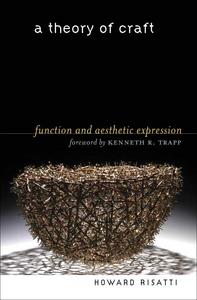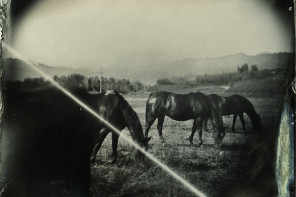 ~ by Jenn Craft and Anna Blanch
~ by Jenn Craft and Anna Blanch
In part I of this post, we looked briefly at the way in which subsuming craft into a definition of art or imbuing craft with a lesser aesthetic value is problematic. This post offers an examination of a theory of Craft that takes a different approach. In order to do this, we will look closely at Howard Risatti’s defense of craft in his A Theory of Craft.* Indeed, Risatti’s theory of craft suggests craft is something slightly different, but no less valuable, than art. It is a theory which privileges the process of making as a fundamental aspect, but does not do so at the expense of the finished work.
A Theory of Craft:
Risatti’s main contribution to the discussion is his attention to what exactly craft objects are along with what it is they actually do. While his theory may not be the defining word on the subject, he makes some helpful points for the discussion at hand.
First, rather than looking at the materials (glass, wood, clay) or technique (quilting, smithing, weaving), Risatti focuses on the function of the objects, that is, what they are actually made for. This is to be differentiated from “use.” While an object may be used in any number of ways other than what it was intended for (for example, a cup could be a paper weight or a painting could be a doormat), the function of the object describes the original intention. A cup was made to function as a container for liquid. Risatti divides craft objects into three main categories: containers, covers, and supports. By defining craft objects by their applied physical function, we are saying something basic about craft that is different from art. Mainly, craft objects, Risatti maintains, are universal to all cultures in the sense that they are made to help us physically interact with the world. Art objects, on the other hand, are specific to the culture in which they are created, so the symbolism invoked in a painting may not be comprehensible to someone outside of that specific context. So regardless of the specific design and aesthetic of a cup, all cultures need something to drink out of. But not all cultures will use or value a painting in the same way.
This is related to the intention of art and craft. Intention is one of the main ways Risatti differentiates art from craft, and he centers his discussion on craft’s physicality and objecthood. While he defines the intention of art as “communication,” the intention of craft is, first and foremost, to make real functional objects. For Risatti, art is first created within the realm of the conceptual and is only incidentally physical, but craft is first physical and then signifies additional meaning and concepts. This is one of the main places where some might take issue in his art/craft distinction. While craft is easily identified first by its physical function, we might ask whether art is only “incidentally” physical? Does an emphasis on physical objecthood really differentiate craft from art in the way that Risatti supposes? He at least makes a valid point: an actual bowl is different from an image of a bowl. The conclusions we draw from this fact are up for discussion, though.
Furthermore, he argues that all craft objects must be handmade. Mechanization takes away the connection with the physical, bodily action of making; “craft” then becomes “product” and no longer serves to connect people with the world around them. This is not necessarily relevant to his distinction between art and craft, since most art is also handmade, but it is important to note in Risatti’s theory since it plays a prominent role in the way he believes the making of craft objects connects people with the world around them. The process of making cannot be separated from how we understand the finished product and the role it plays.
Finally, in craft, function is related to aesthetic, utility with beauty. Aesthetic concerns aren’t taken away in craft production; they are just seen in close kinship with applied functionality. Risatti still wants to claim that just like you can make value judgments about art, you can make value judgments about craft. But generally, this is tied up in both the aesthetic aspects of the piece and the technical process. So if we judge a craft object to be “good’ or “valuable,” as it were, it will be well-made and beautiful.
Conclusions:
Much more, of course, could be said on the matter of craft. What is perhaps most beneficial to note here is the distinction Risatti makes about intention in craft. He accepts the intention of art to communicate, though he does not deny the possibility of craft communicating; he simply suggests it is a secondary concern to function. In fact, the main value he finds in craft objects is that they merge the practical/physical with the conceptual/symbolical. In this way, the making of craft objects is related to Aristotle’s poeisis, knowledge that comes from making or producing something. Through craft, we simultaneously gain knowledge about the material world and are able to “place” ourselves conceptually within it. One might argue, however, that art does this in another, albeit slightly different, way. But even if we maintain that the process of making art fits within Aristotle’s category of poeisis alongside craft, we still have to ask the question whether the physical object and process of art is different from craft, and if so, what this suggests about their relationship and roles.
Despite these further questions, Risatti helps us identify some of the major things about craft objects that make them so important and special. In this way, he has contributed something valuable to the discussion and elevates craft once again to an arena of dialogue with, rather than subservience to, the arts.
*Howard Risatti, A Theory of Craft: Function and Aesthetic Expression. Chapel Hill: University of North Carolina Press, 2007.





This post is really fascinating: thanks! So, just to clarify the relationship between the crafts and the arts, are you saying that these are different spheres and that they don’t overlap, or that they are related spheres that do overlap? If the latter is the case, then are there art-crafts that are functional but prioritize communication, and craft-arts that communicate, but prioritize functionality?
Jenn and Anna, thanks for this interesting discussion of Risatti’s book. It sounds like a very interesting read! From my perspective, it appears that your post is making the same sort of distinction between art and craft that Wes and Jim’s post is making. Both posts define art as communication. And, although Wes and Jim are emphasizing that craft can communicate (something you say that crafts often do), your main point appears to be that craft is made for “applied physical function.” On this basic point, it seems to me that you are all in general agreement, and that it would make sense for Wes and Jim to include this distinction within their own philosophical framework. Someone, please correct me if I am not seeing the differences clearly enough!
Where I disagree with all four of you is on the idea that art is communication. The very problematic nature of such a statement is brought out by the way that ‘communication’ and ‘function’ are being juxtaposed in this post. It seems me that this juxtaposition derives from a category mistake. Are you not saying that communication is the function of art? If communication is a function then they shouldn’t be juxtaposed to each other. Or perhaps you are saying that communication is a special function that we reserve primarily for works of art. But I see no convincing reason why we should say that art performs only this function and not others. The idea that art is made for communication seems to be a peculiarly modern idea supported by the infrastructure of the art industry (galleries, museums, etc.) that presents works of art as if they had no other function in human life. But prior to the ‘age of the museum’ many of the objects we refer to as ‘works of art’ were deeply embedded within social, political and religious life. So, for example, a religious work of art such as an icon performs not only the function of communication, but it is also an aid in the worshipper’s devotion and prayer.
I am especially skeptical of the idea that a work of art exists primarily in the conceptual world, or that the materiality of a work of art is incidental to its being a work of art. This way of looking at works of art suggests to me that artists ‘know’ what they want to communicate before they begin interacting with material, and that the materials themselves do not contribute anything to the meaning of a work of art.
A brief word on this. The important difference between this post and what James M and I are referring to as “the craft of art” is that we are talking about craft-as-skill-and-style versus craft-as-object. In addition, I want to argue that crafts-as-objects are included within the realm of art, which I do not think has to make them subservient in any way.
Regarding communication, I still think all art creates a communicative event, whether or not the artist intended a certain meaning or even desired to communicate something. It is not that art is made for communication, but that by making art, communication happens. Indeed, every human act communicates something just by virtue of happening. You are right, Jim, that discerning what a work of art is “about” should not always be the primary task, but that does not negate the fact that it is a communicative object.
Hopefully we can clarify this a little in our post next week on the “content of art,” which should stir some responses. But I don’t want to distract too much from this great post.
My general response to this particular post is that I think these are some helpful distinctions for what makes crafts-as-objects a particular kind of art, not how they distinguish crafts-as-objects as something other than art.
Hi folks — good to see the dialogue continue. However, I do think there is a bit of confusion brewing, and James nailed the main problem in the dialogue — a category mistake. Beyond this, there is an additional ontological problem — namely the meaning and status of the object-hood of the work of art. Art is not, strictly speaking, communication. Art does indeed communicate, as do Risatti’s crafts objects. Art does result in knowledge, though art is not a form of knowledge. And art does result in action — though strictly speaking art is not only a form of action. Art is, as the French say, facture. It is making — a properly basic mode of being that humans engage in. Human beings know, act, and make — all related but distinct modes of being in the world. Separating out craft from art seems, as I said in a previous post, a nearly futile endeavor — and that is because art employs craft and craft employs art, and both are a species of making, of facture. For the sake of clarification, I’ll hazard a pretty bold statement as an artist who has been painting for forty years: I am a thinker, I am a speaker and actor in this world — but I am also a maker (made in the image of a Make) and I understand these different ways of being as separable but deeply intertwined. Furthermore, it seems to me that making distinctions in this particular conversation is only useful for emphasis — for no other reason. I don’t think Jen, Anna, Wes, or Jim want to distinguish these things in order to gain an upper hand — which I do think has been the case in some conversations in aesthetics. The political aspect of the craft/art dichotomy is pretty obvious — and I think it has led us down a tortuous and fruitless path over the past couple centuries. I operate from a standpoint of grounded, humble craft on the one hand and an improvisational intuition on the other. Both the improv and the handicraft aspects are pivotal to my making of paintings — and sometimes they are one and the same thing. (Something Jim hinted at toward the end of his comment.) Cheers all round — and joy over the weekend!
My concern with Bruce’s response is that it would seem to lead to a familiar cul-de-sac that in principle “everyone is an artist” and everything is an art and therefore there is no effective way of distinguishing “art” from anything anybody wants to declare to be “art.” I find that an unsatisfying account of the phenomenon we call, for lack of a better term, Art.
I do find it helpful to discuss art as fundamentally a phenomenon of “making” (as long as this can include performance as well). This is why I insist on the dimension of craft in art. But making to what end? This is where I believe a distinction can be made between the objectives of craft and art, and both have their excellences in their respective ways. My contention that art is a form of communication is because I want to identify to what end the making takes place, and to distinguish it between any number of other worthy forms of making that do not, at least in my classification (not evaluation), represent art.
Jim Watkins has helpfully identified a problem of categorization in our discussions about craft. I perhaps unhelpfully slide between speaking about craft as process and craft as final product. But the object of analysis in the articles Wes and I are working on is not craft but art, and we are trying to affirm the special status of art by highlighting the craft (techniques, skills) behind it and understand what differentiates a well-built cabinet beautiful in design from a well-built installation art work intended for an artists’ next exhibition. Something different is going on. What is it?
James (and friends),
Thanks for your response — in fact I share your concern over the dimension of craft in art, as I think my four decades of investment in it show. I don’t think that my comment necessarily leads to the conclusion you draw from it at all. The leveling of all forms of art and craft was not at all my intention — in fact it was the reverse. Yet I do think that there are plenty of works of “art” that are inferior in both craft and art to “craft” works in both respects. The real issue it seems to me is, as you have said, one of intention — and perhaps even more importantly, those aspects of culture making that are semi-conscious at best — what might be called the “infection” of art (Tolstoy).
Moreover it was not my thought that “anyone can be an artist and everything is art” — also quite the reverse. My intent was to clarify what I think the distinction is between knowing, communicating, and making is on the one hand, and how making art is fundamental to humanness on the other. I wasn’t arguing that no distinctions can or should be made, yet I do think sometimes theorists make the distinction mostly in order to baptize their own pet projects with the exalted status of “art”. To some extent I agree with Hans Belting that art history seems to fall into three large shifts: art before Art (largely religious in nature); art as Art (those centuries following Vasari wherein art is accorded exalted status, as were the luminaries — the Great MEN of art); and finally art after Art (our own times following DuChamps, Warhol, et al where the boundary between art and the rest of life has been blurred or erased, and where a mockery has been made of the high pretense of Art with a capital A). Though I am not an enthusiast of Arthur Danto, he has neatly laid all this out in his book After the End of Art.
Cheers, Bruce
Bravo all! There will forever be discussion on this topic. I, too, am very concerned with the idea of it all, but I believe the very reason art and crafting are so special is because everyone experiences them differently. Would we even be having a discussion on the thought of it if there were one simple way to differentiate between the two?
It was explained to me once in a discussion much like this that an artist takes all he knows about the process of creating and brings it together with intent, and in the process of manipulating the media, he unloads the human spirit into the work.
It is impossible to understand a work of art from any perspective outside of our own. What a piece means to the creator is commonly very different from that of the viewer. We are all influenced by our individual circumstances and experiences that we have accumulated throughout our lives. Even if we tried to translate the meaning of something to others we would be limited my language. The classification of things is only relevant to the one doing the classifying. Down to our idea of explaining the differences we are limited by language. The essence of the words characterizes the whole discussion by the experiences each person has of those words (such as the discussion above of the word functional). It really is a futile, endless discussion. Although, I’d say it is a great one.
Everything is so relative that the question will never fully be answered. There are too many creators of things in the world to label each person… each item… each act as art or craft.
Thank you for this discussion. I have greatly enjoyed the opinions and perspectives of other interested parties. Have a great week. Be blessed!